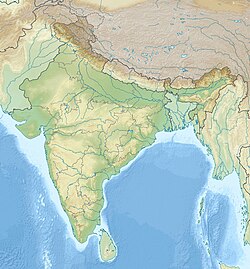1905 Kangra earthquake
| UTC time | 1905-04-04 00:50:00 |
|---|---|
| ISC event | 16957848 |
| USGS-ANSS | ComCat |
| Local date | 4 April 1905 |
| Local time | Early morning |
| Magnitude | 7.8 Ms[1] |
| Epicenter | 33°00′N 76°00′E / 33.0°N 76.0°E[2] |
| Fault | Main Himalayan Thrust |
| Areas affected | Colonial India |
| Max. intensity | EMS-98 IX (Destructive)[3] MMI X (Extreme)[4][5] |
| Casualties | >20,000[2][1][6] |
The 1905 Kangra earthquake occurred in the
Background
The calculated epicenter of the earthquake lies within the zone of thrusts along the front of the Himalayas formed by the continuing collision of the Indian plate into the Eurasian plate.[10] Underthrusting of the Indian subcontinent beneath Tibet along a 2,500 km long convergent boundary known as the Main Himalayan Thrust has resulted in the uplifting of the overriding Eurasian plate, thus creating the long mountain range parallel to the convergent zone.[11]
Earthquake characteristics
The magnitude 7.8–7.9 earthquake struck the western Himalaya in the state of Himachal Pradesh at an estimated depth of 6 km along a very shallow dipping thrust fault, likely on the Main Himalayan Thrust detachment. The rupture area is calculated at 280 km × 80 km.[12] The rupture did not reach the surface, therefore, is considered a blind thrust earthquake.[12] A more recent study in 2005 estimated the rupture zone at 110 km × 55 km while still not breaking the surface.[13]
Damage
The earthquake reached its peak Rossi–Forel intensity of X in Kangra. About 150 km away from this zone to the southeast, an area of increased intensity reaching VIII was recorded. This unusually high intensity away from the earthquake in the Indo-Gangetic Plain included the cities Dehradun and Saharanpur. It was felt VII in towns like Kasauli, Bilaspur, Chamba, and Lahore.[14]
As many as 100,000 buildings were reported to have been demolished by the earthquake. At least 20,000 people are estimated to have been killed and 53,000 domestic animals were also lost. There was also major damage to the network of hillside aqueducts that fed water to the affected area. The total cost of recovering from the effects of the earthquake was calculated at 2.9 million (1905) rupees.[1]
See also
References
- ^ a b c Ambraseys, N.; Bilham, R. (2000). "A note on the Kangra Ms = 7.8 earthquake of 4 April 1905" (PDF). Current Science. 79 (1). Current Science Association: 45–50. Archived from the original (PDF) on 4 March 2016. Retrieved 9 January 2014.
- ^ ISBN 978-0124406520
- doi:10.1785/0120080328, archived from the originalon 12 November 2016, retrieved 19 February 2017
- S2CID 129961165. Retrieved 18 March 2021.
- S2CID 140177028. Retrieved 18 March 2021.
- S2CID 26641327.
- ^ Dharamsala Earthquake 1905 – Images
- ^ History Archived 2007-12-21 at the Wayback Machine Kangra district Official website.
- ^ Earthquakes The Imperial Gazetteer of India, v. 1, p. 98.
- ^ Wallace, K.; Gaur, V.; Blume, F.; Hough, S.; Bilham, R., Geodetic Study of the Kangra Earthquake 1905 (PDF)
- PMID 28900236.
- ^ S2CID 127752208. Retrieved 18 March 2021.
- ^ Bilham R, Wallace K (2005). "Future Mw 8 earthquake in Himalaya: Implication for the 26 December, 2004 M = 9 earthquake on eastern margin". Geological Survey India. 85: 1–14.
- ^ "Significant Earthquake Information INDIA: KANGRA". NGDC NCEI. NCEI. Retrieved 18 March 2021.
Further reading
- Middlemiss, Charles Stewart (1910). The Kangra Earthquake of 4th April, 1905. Geological survey of India.
- Ambraseys, N. N.; Douglas, J. (2004). "Magnitude calibration of north Indian earthquakes". Geophysical Journal International. 159 (1): 165–206. ISSN 0956-540X.
- JSTOR 24110489
- Srivastava, H. N., Mithila Verma, and B. K. Bansal. "Seismological Constraints for the 1905 Kangra Earthquake and Associated Hazard in Northwest India." Current Science 99, no. 11 (2010): 1549–559. http://www.jstor.org/stable/24069452.
External links
- The International Seismological Centre has a bibliography and/or authoritative data for this event.

